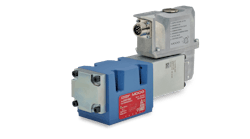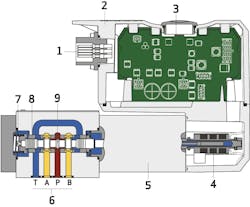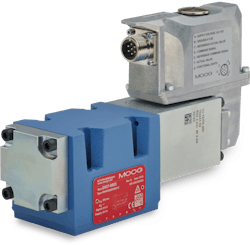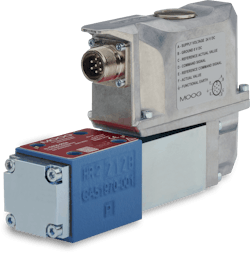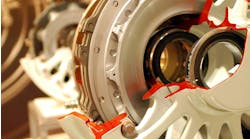Expanded Hydraulic Valve Portfolio Brings New Market Opportunities
Direct operated valves are those which use integrated electronics to operate a spool within the valve. A current is applied to move the spool and control hydraulic flow.
Robert Forisch, Product Marketing Manager, Valves at Moog Inc., said there are three main operational principles which have typically been used to move the spool in direct operated valves – solenoids, linear force motors and voice coils. These devices are connected directly to the spool to enable its movement.
The chosen operational principle varies by manufacturer and is often dependent upon the performance capabilities possible, such as control accuracy, and price. He said valves using a voice coil or linear force motor are generally more expensive than solenoid operated options.
For many years, Moog’s direct operated valves have utilized linear force motors to move the spool. Many customers have expressed to the company that while they liked these valves, called direct drive valves (DDV), the price and performance were too high for their application requirements.
Due to this customer feedback, Moog began a project to add four direct operated valves with solenoids to its portfolio.
Solenoid Operated Valve Opens New Market Opportunities
By adding valves operated by solenoids to its lineup, Moog was able to expand the applications and markets in which its direct operated hydraulic valve technology is utilized.
One of the advantages of these valves is that they can easily replace other valves, said Forisch. He explained that one of the challenges noted by customers with the DDV is their size; inclusion of a linear force motor creates a different overall size envelope which needs to be accommodated. And if wanting to use a Moog DDV in place of a direct operated valve equipped with a solenoid, it often will not fit within the machine. However, a Moog direct operated valve will easily fit.
“Once we decided to go for the solenoid design…it made the valves swappable with all the others in the market,” he said because the majority of direct operated valves utilize a solenoid. Use of a solenoid instead of a linear force motor creates a more compact valve that can easily fit into various machine designs. These valves are also easy to use, an important aspect to many customers.
These factors, combined with the improved price to performance ratio compared to the DDV line, helps to make the direct operated solenoid valves an attractive product for different kinds of machines and markets said Forisch.
Moog has traditionally focused on serving high-performance markets where the customers are looking for the best product they can get in the market, he said. But there’s always other customer levels which do not require high-performance solutions and may be more cost sensitive. As these machines may have lower performance and output requirements, they are looking for a different kind of hydraulic valve such as the direct operated valve with a solenoid.
An example given by Forisch is blow molding machines – there are high-performance versions but also lower performance machines for which the solenoid operated valves would be a fit. In these machines, the valve is used for parison control, i.e., controlling the thickness of the material as it is blow molded.
Moog’s solenoid operated valve is able to provide the control accuracy desired in this and other industrial machinery applications while also offering a high level of resistance to vibration and temperature to withstand use in harsh operating environments. Essentially, the company took its experience developing valves for high-performance markets and adapted it to suit the needs of other markets as well.
READ MORE: Understanding Proportional Control Valve Circuits
Advancements in Electronics will Benefit Future Valve Designs
When it comes to the future of direct operated hydraulic valve designs, Forisch said the electronics used with these components is where he sees the potential for technological developments.
The hydromechanical portion of these valves – the valve housing and spool – have essentially used the same design principle for the past 50 years and he does not see any significant changes coming for them in the future.
Forisch said there are a lot of ideas in the hydraulics market about how to improve the energy efficiency of the hydromechanical portion of valves. “But it’s such a fundamental change to the operational principle that you cannot easily swap it into a machine,” he said. “That means you have to rethink the whole machine, not just the valve.”
It is possible there will be some developments related to the manufacturing process for the valve body and the spool. But in general, he does not foresee fundamental changes coming for the hydromechanical portion of these hydraulic valves or the solenoids used with them.
The electronics used with valves, on the other hand, is an area he does see the ability for manufacturers to differentiate themselves from their competitors and where further developments are possible.
Over the years as electronic feedback was added to valves, the industry began using analog and transitioned to digital electronics. Then in the mid-2000s, Forisch said there was a push toward using fieldbus communications which allowed more features and functionalities to be included. In addition, different interfaces such as IO-Link, became possible and in more recent years there has been a lot of discussion around use of the Internet of Things (IoT).
READ MORE: IoT Enables Better Problem Solving in Fluid Power
The next evolution, he said, will be integrating direct operated valves into larger monitoring systems to learn more about the condition of the valve. This will enable machine owners to see how much performance life is left in their valve so it can be replaced before it breaks and causes a major issue.
Forisch said there is still some way to go in achieving this. While companies like Moog have a long legacy of developing valves, and thus understanding what causes them to eventually fail, he said there are still so many variables to take into account. There are variables such as how the machine is used, the quality of the oil, and many more.
“As of today, you are not able to collect all of them,” he said. “There are so many variables that define lifetime and I do not have any control or information about them [making] this kind of condition monitoring hard to accomplish.
“At the end of the day, it will be a combined effort not only by the valve manufacturer but also the machine manufacturer and the operator all [working] together because you need information from various parts of the machine to do something like predictive maintenance and condition monitoring.”
Data is another factor which needs to be taken into account – who owns it, where is it stored, who is allowed to access and evaluate the data. “Even though we have ideas to do it, at the moment we struggle with collecting information from others and defining the boundaries [related to] access,” he said.
Forsich concluded that adding condition monitoring and other functionalities is a development area of focus for Moog and much of the hydraulic valve industry. Continued advancements in the capabilities of digital electronics will enable a more sophisticated way to communicate and monitor valves now and into the future.
